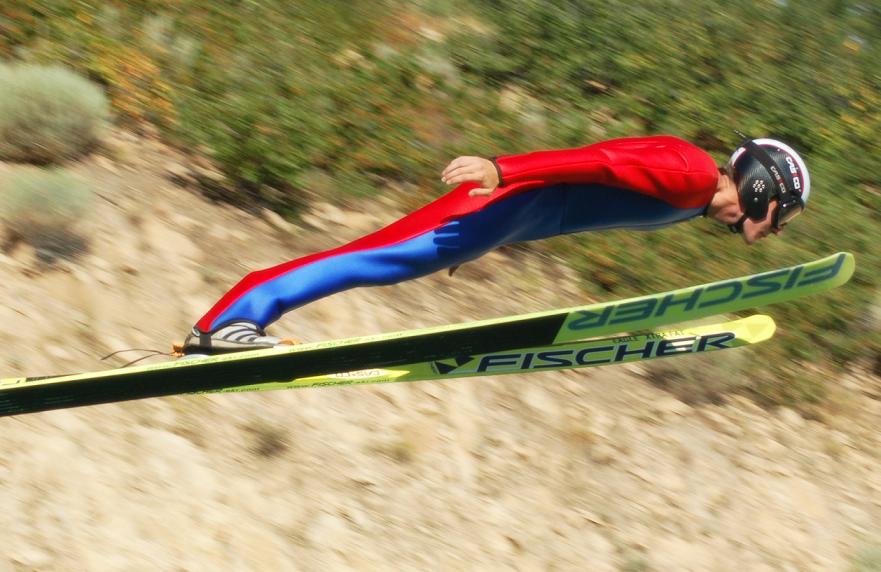
The main idea in ski jumping is to fly as far as possible. While that sounds simple, delve a little deeper and you'll find that ski jumping is full of nuances that ad loads of depth to the sport.
THE HILL
Ski Jumping hills are not just a random big ramp, they're designed very carefully to provide a great ski jumping experince...well, at least the good ones are. There are four main sections of a ski jumping hill. These include the inrun which is the ramp, the takeoff, the landing hill, and the outrun which is where a skier slows down and stops.
the Inrun
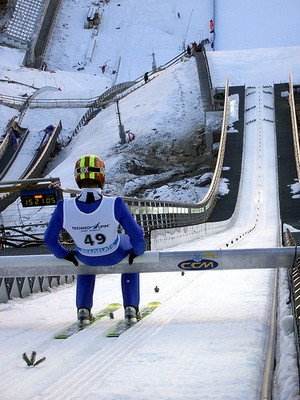 The inrun is the large ramp used to gain speed before taking off into the air. There are many "gates" or starting positions on the top of the inrun so that a skier can choose roughly how fast he'll be going. The faster you go the farther you fly, so naturally the higher up on the hill you start, the easier it is to go far. In competitions every competitor must go from the same gate to ensure fairness. Usually there are two grooves cut into the snow or ice for the skis to travel down in a straight line. In the past ski jumpers didn't have this luxury, but today its common practice.
The inrun is the large ramp used to gain speed before taking off into the air. There are many "gates" or starting positions on the top of the inrun so that a skier can choose roughly how fast he'll be going. The faster you go the farther you fly, so naturally the higher up on the hill you start, the easier it is to go far. In competitions every competitor must go from the same gate to ensure fairness. Usually there are two grooves cut into the snow or ice for the skis to travel down in a straight line. In the past ski jumpers didn't have this luxury, but today its common practice.
the Takeoff
The takeoff is where the skier leaves the inrun and enters their flight. Despite popular belief, the takeoff on a ski jump does not have a kicker to launch a skier into the air. There is actually an 11 degree hang, which means that a ski jumper must really jump to go any significant distance on a jump.
the Landing hill
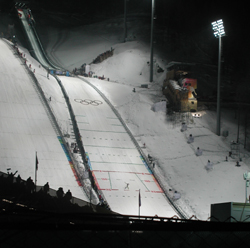 The landing hill is where the ski jumper lands. Obviously. There are two main points on the landing hill that you should know about. The first is the "P" point which is where the landing hill reaches its steepest grade. The second is the "K" points which is where the hill begins to flatten out again towards out run. The distance of the K point is how one refers to the size of a jump. For instance, a 90 meter ski jump has a K point at 90 meters. The easiest part of the hill to land on is between the blue and red line, or the P and K points. Past the K point it can become very difficult to land. The flatter the hill, the harder the impact.
The landing hill is where the ski jumper lands. Obviously. There are two main points on the landing hill that you should know about. The first is the "P" point which is where the landing hill reaches its steepest grade. The second is the "K" points which is where the hill begins to flatten out again towards out run. The distance of the K point is how one refers to the size of a jump. For instance, a 90 meter ski jump has a K point at 90 meters. The easiest part of the hill to land on is between the blue and red line, or the P and K points. Past the K point it can become very difficult to land. The flatter the hill, the harder the impact.
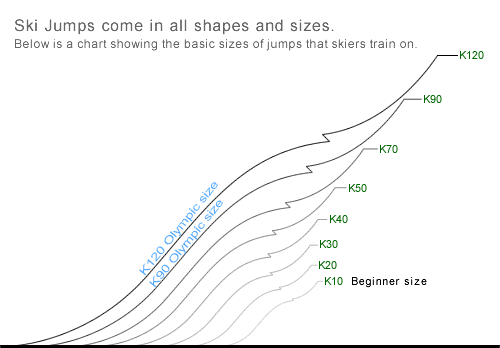
the Outrun
Theres not really much to say about the outrun, its simply the area at the end of the hill where the skier slows down and comes to a stop. Some hills have a steep counter-slope to help slow the athletes down.
TECHNIQUE
Ski Jumping technique is about trying to get the most powerful jump against the takeoff while maintaining as much of your speed as possible. On the inrun the skier crouches down and sits in an inrun position. At the takeoff the jumper leaps up and forwar at a 45 degree angle while keeping his chest close to parallel with the ground. In the air the skier strecthes out over his skis. By spreading his skis into a "V" position a jumper can create more surface area and glide farther down the hill. When landing a good ski jumper will spread his feet apart into a telemark position, with one foot in front of the other and knees bent comfortably. In competition style points are deducted by the judges if a jumper fails to put in a good enough telemark landing.
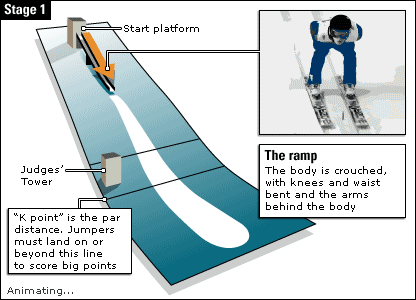
SCORING
Ski Jumping is all about going far, and looking good doing it. Skiers are scored on both distance and style. A normal competition consists of a trial or practice jump and two competiton jumps. The scores from each jump are added to make the jumpers total score. There are five judges, who can each give a score of up to 20 points per jump. The highest and lowest scores from the judges are discarded meaning that the most style points possible on one jump is 60. Distance is scored by how far a jumper flies relative to the K point (kritical point, red line). A jumper earns 60 points if he reaches K point. Points are either added for going farther the K point or taken for going shorter. On a large hill competition, every meter farther or shorter than the K point adds or subtracts 1.8 points, and on the normal hill its 2 points rather than 1.8. The distance of a jump is measured from the end of the takeoff to the point on the hill where the middle skiers feet land (measured to the nearest half meter).